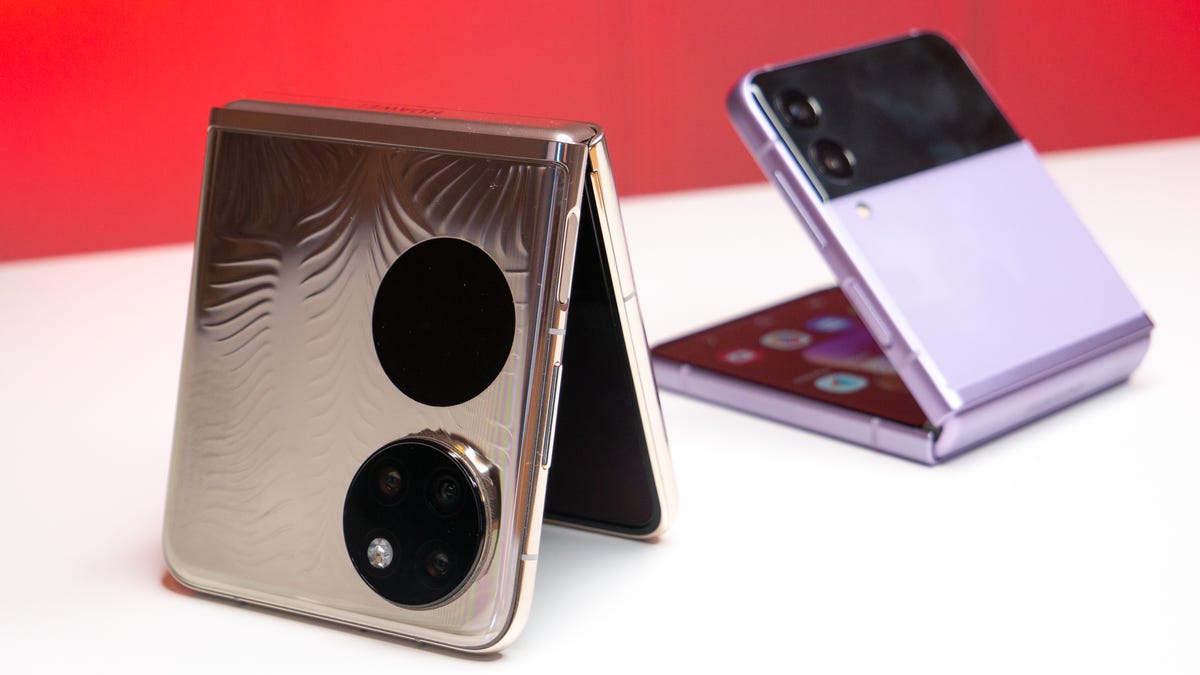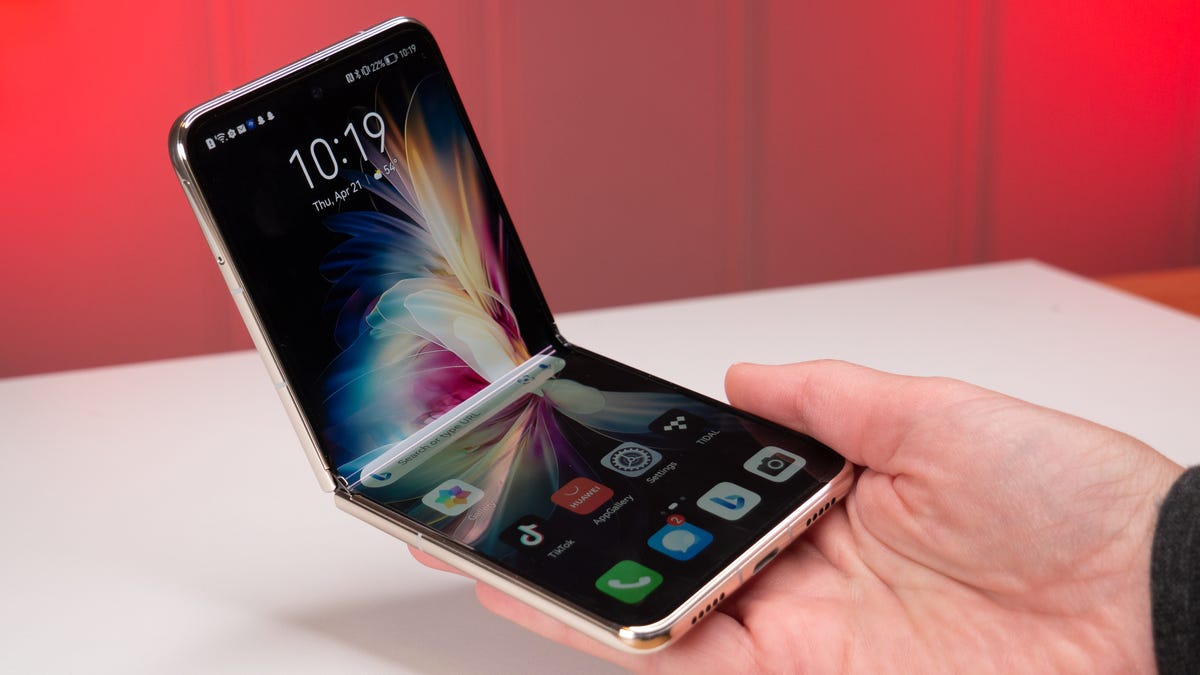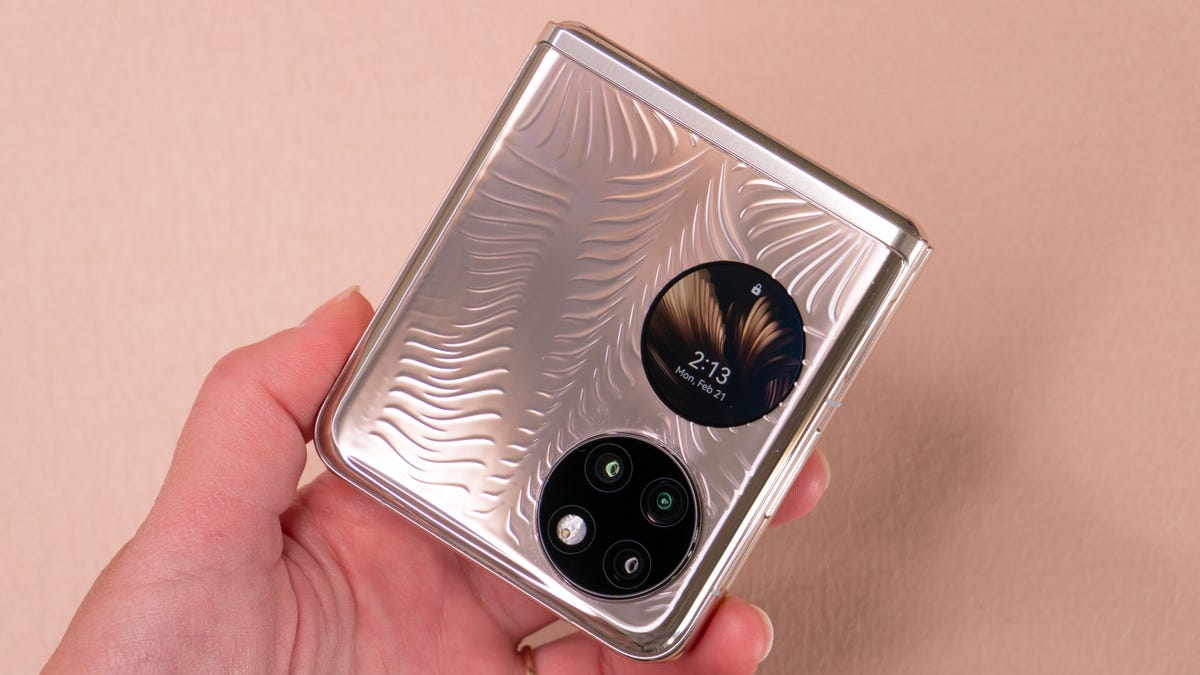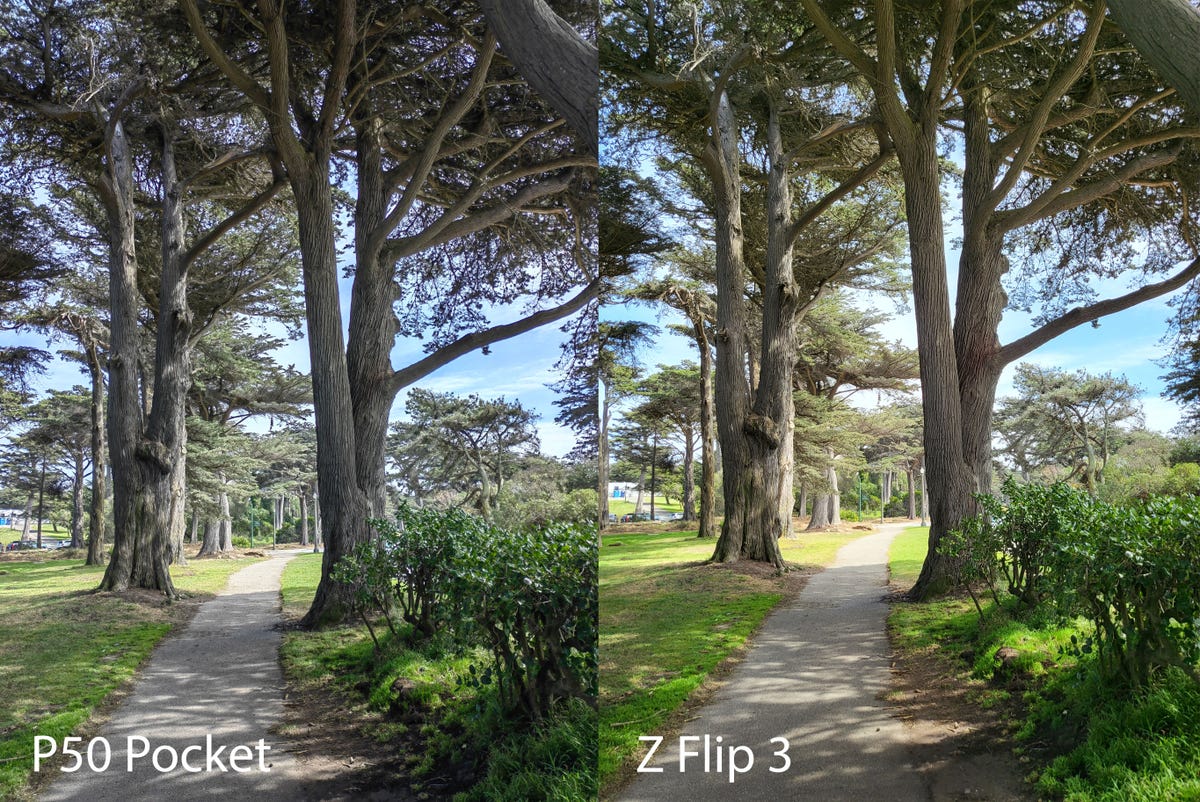The Huawei P50 Pocket is the sort of phone that will turn heads. Not only is it a foldable flip phone, but its unique patterned finish makes it feel part tech gadget, part fashion accessory. It has a different appeal that makes it stand out among other foldable phones out today. Huawei might not be able to sell the P50 Pocket in the US due to ongoing government restrictions, but it has several features that could be adopted by other flip phones we can buy.
I’ve been using the P50 Pocket for the past month with the Samsung Galaxy Z Flip 3 to see what the next generation of flip phones like the Flip 4 could take on board. The P50 Pocket starts at 1,299 euros (equivalent to $1,400, £1,080 and AU$1,910) but the premium gold finish on the model I’ve been using costs an eye-watering 1,599 euros. There’s a joke here about needing deep pockets, but I’ll let that one slide for now.
It’s important to note that Huawei’s phones can’t use Google apps and services, which means no Gmail, Google Maps, YouTube or the Play Store. This puts it at an immediate disadvantage compared to other Android flip phones available today, including Samsung’s phones and the Motorola Razr. Instead, it runs Huawei’s EMUI 12 operating system, which is based on an open-source version of Android. There’s also no 5G connectivity, a huge downside for a phone released in 2022 — especially at this price.

It would be remiss to not mention how visually appealing this phone is, particularly in the gold etched edition.
Lexy Savvides/CNET
The P50 Pocket screen reduces the crease… and glare
Huawei’s phone has a seamless hinge, the same design Motorola used on the 2020 Razr, so there’s no gap between the screen when you snap it shut. There’s less room for dust and debris to settle in the gap. The crease is also less prominent than on Samsung’s phone, both to the eye and to the touch. When scrolling apps or web pages, I’ve noticed it gets under my thumb far less than the crease on the Z Flip 3. To be fair, after a few days I definitely don’t notice the crease as much on the Z Flip 3, but in certain lighting conditions and when watching videos or movies, it suddenly pops back into view.
The P50 Pocket’s screen is also less reflective than the Z Flip and that’s something I hope Samsung really does take into consideration in the design of its next flip phone. The P50 Pocket is easier to see outside, not because of its maximum screen brightness, but because there’s not as much glare thanks to the anti-reflective coating.


The P50 Pocket is easier to see outside.
Lexy Savvides/CNET
There are, of course, compromises with the hinge on the P50 Pocket as it doesn’t stay open as easily as the Z Flip 3. Most native apps also aren’t optimized for split screen mode either, unlike Samsung’s phone.
It would be remiss to not mention how visually appealing this phone is, particularly in the gold etched edition. It’s ostentatious in all the right ways and really nice to see a manufacturer taking risks with a finish like this. I also love the aesthetics of the circular display, especially how its size mirrors that of the camera module. Sometimes I look at the phone and see two googly eyes staring back, which is just fun and something I can’t say about the Z Flip 3’s display. Sure it’s more practical for reading text notifications, but just doesn’t have the same wow factor.


Googly eyes sorta included.
Lexy Savvides/CNET
You don’t sacrifice camera quality on this flip phone
Camera features we take for granted today, like ultra-wide lenses, larger image sensors and low light performance, owe a lot to earlier Huawei phones like the P20 Pro and P30 Pro. Even though the P50 Pocket’s cameras lack the headline-grabbing features its predecessors had, they do show that you don’t need to compromise on image quality when choosing a flip phone.
The P50 Pro’s main wide-angle camera has better dynamic range than the Z Flip 3. I noticed it most when taking landscapes as you can see it retains more detail in highlight areas, like the sky in the image comparison below. It also performs better for low-light shots and for video recording on the main camera at 4K/60fps.


Even at a reduced resolution you can see the P50 Pocket has better dynamic range in this shot as less detail is lost in the highlight areas in the sky.
Lexy Savvides/CNET
Colors on the P50 Pocket also look more natural than the Z Flip 3, which tends to over-saturate images on default settings. That’s more of a personal preference than anything, but I generally preferred the images straight out of the Huawei phone. There’s also a macro mode that really lets you get up close on the P50 Pocket and the ultra-wide camera has autofocus, which the Z Flip 3 lacks.
Also, the 40-megapixel sensor on the P50 Pocket lets you want to take even higher resolution images if you choose. That said, these photos don’t look as good or as sharp as its 10-megapixel shots.
A bigger battery will last you the entire day
The P50 Pocket comes with a 4,000-mAh battery, a higher capacity than the dual 3,300-mAh batteries on the Z Flip 3. In my colleague Patrick Holland’s review, he noted that the Z Flip 3’s battery life was one of the more significant downsides. With three or four hours of screen-on time using the 120Hz display, he needed to charge the phone after 11 hours.
So the P50 Pocket’s bigger battery will let you go a bit longer between charges and the phone also supports 40-watt wired charging. You do need to have the Huawei SuperCharge charger to take advantage, but even with my regular 25-watt adapter I was able to juice up the P50 Pocket from flat to full in a little over an hour. I found myself really missing this faster charging when I switched back to the Z Flip 3 that maxes out at 15 watts.
The P50 Pocket also has the option of expandable storage up to 256GB via nano memory card, which is a huge advantage for people like me who like to take lots of photos and videos.
But the P50 Pocket isn’t a slam dunk… yet
Apart from the obvious issues around availability and its incredibly high price, there are several things the P50 Pocket doesn’t do as well as Samsung’s flip phone. The Z Flip 3 is rated IPX8 which means you can dunk it in up to 5 feet (1.5 meters) of water for up to 30 minutes. Naturally I had to test this claim for myself and spoiler alert: the phone survived. Even eight months later, I’m still using the Z Flip 3 I submerged in both fresh and chlorinated water, with no issues to report.
With the P50 Pocket, there isn’t a water resistance or durability rating whatsoever. I only used the phone for a month and have been pretty careful with it during that time, but there’s no way to tell how it will fare long-term — or if I end up dropping or dunking it accidentally.
Then there’s connectivity. The P50 Pocket only supports 4G LTE which is one of the biggest issues considering its price. If you’re thinking of holding on to your phone for several years this could be more of a downside than you might think, especially as 5G connectivity continues to roll out across the world. Huawei’s EMUI also has a significantly higher learning curve than I’d like, particularly when it comes to its aggressive battery management.



